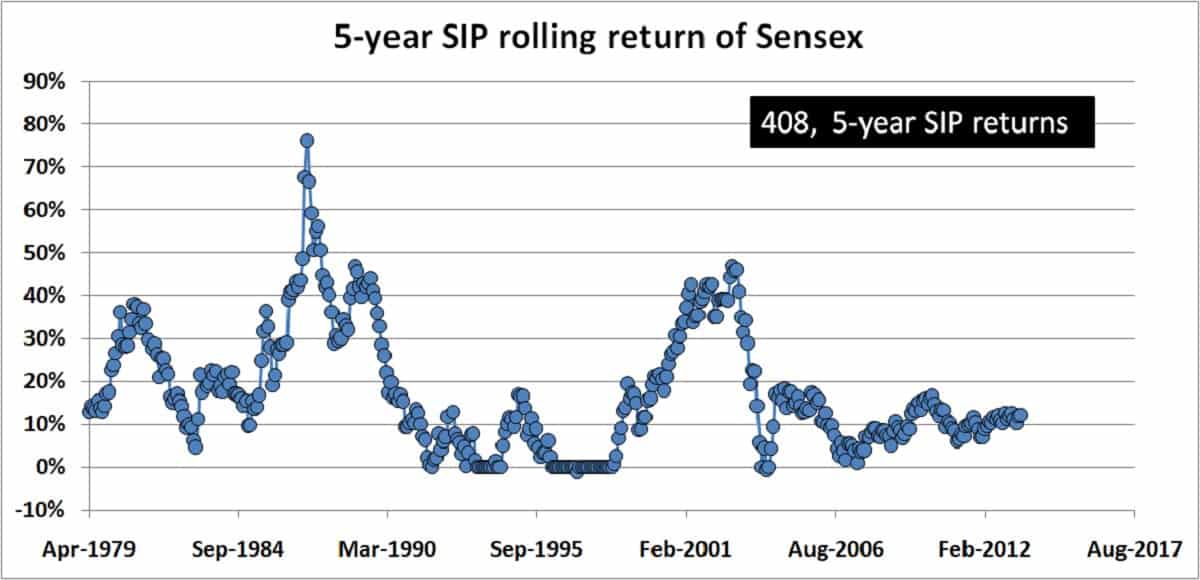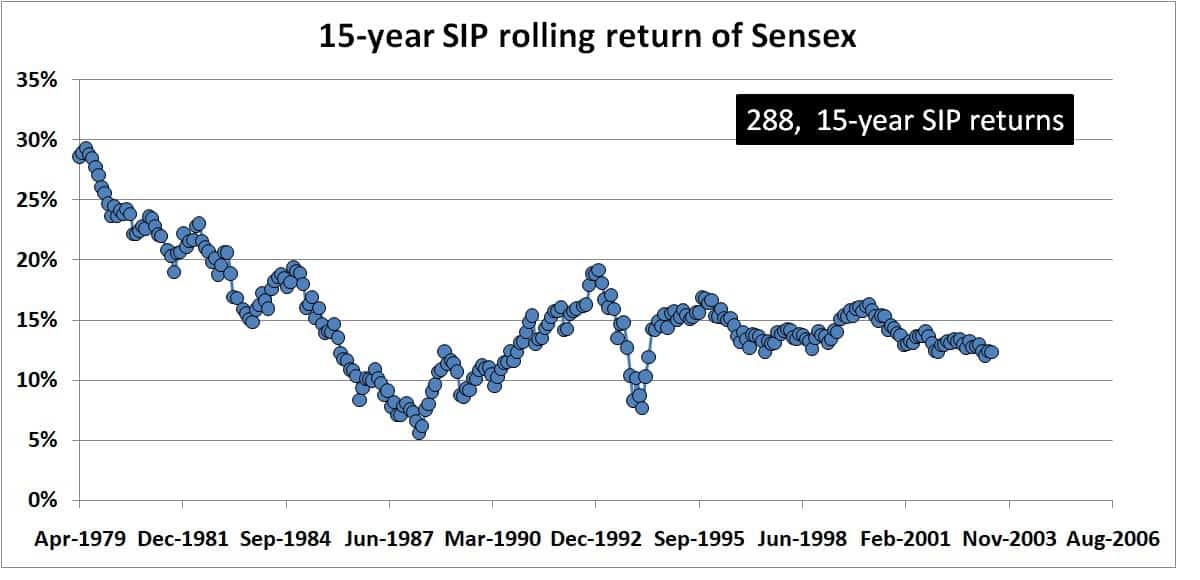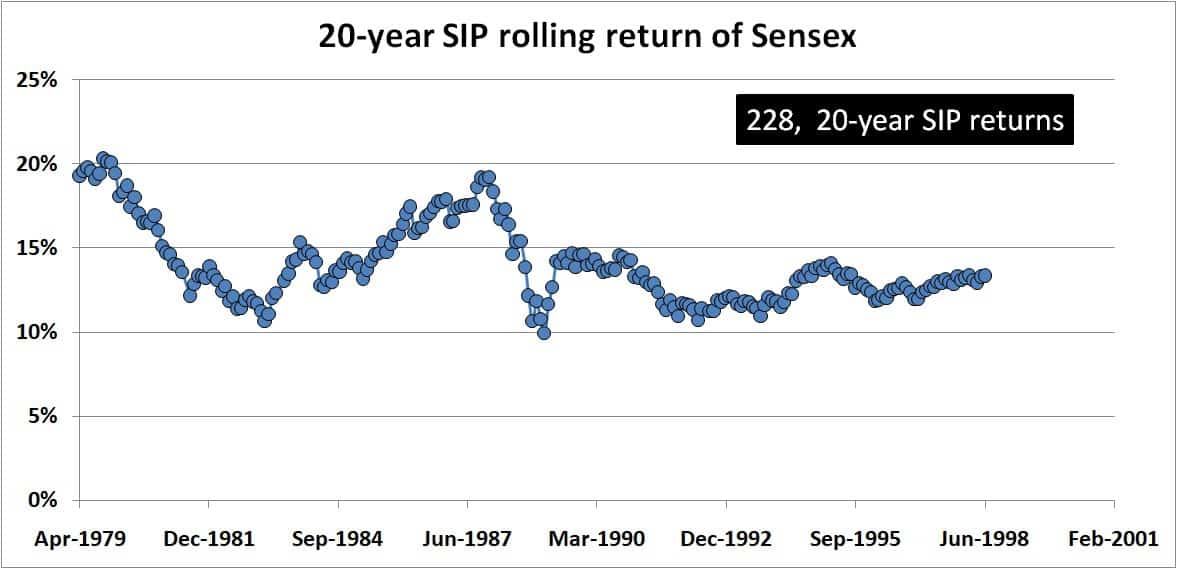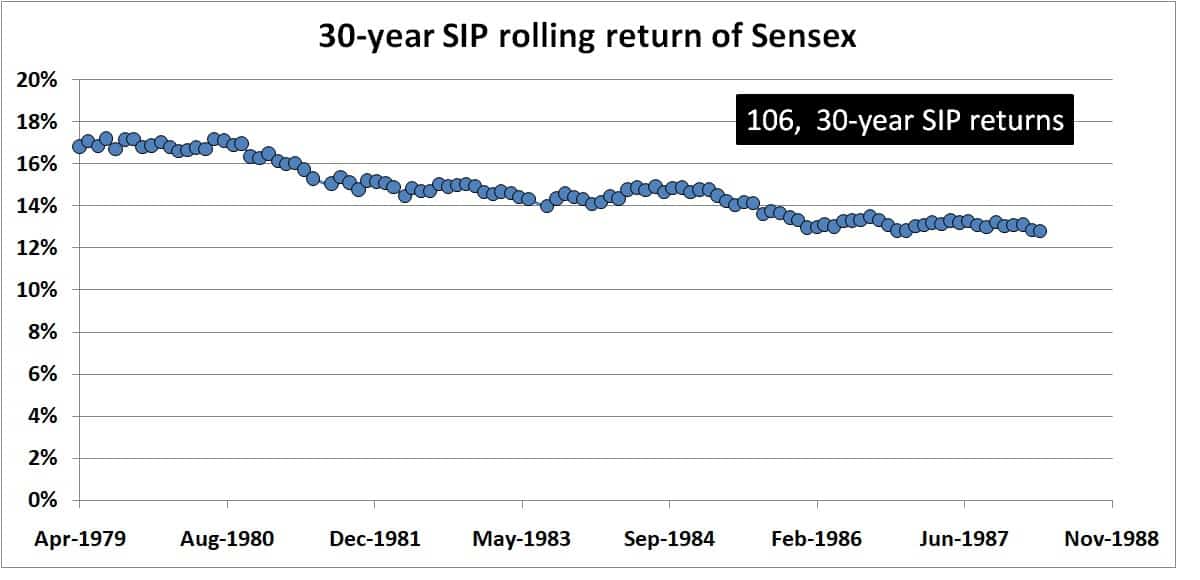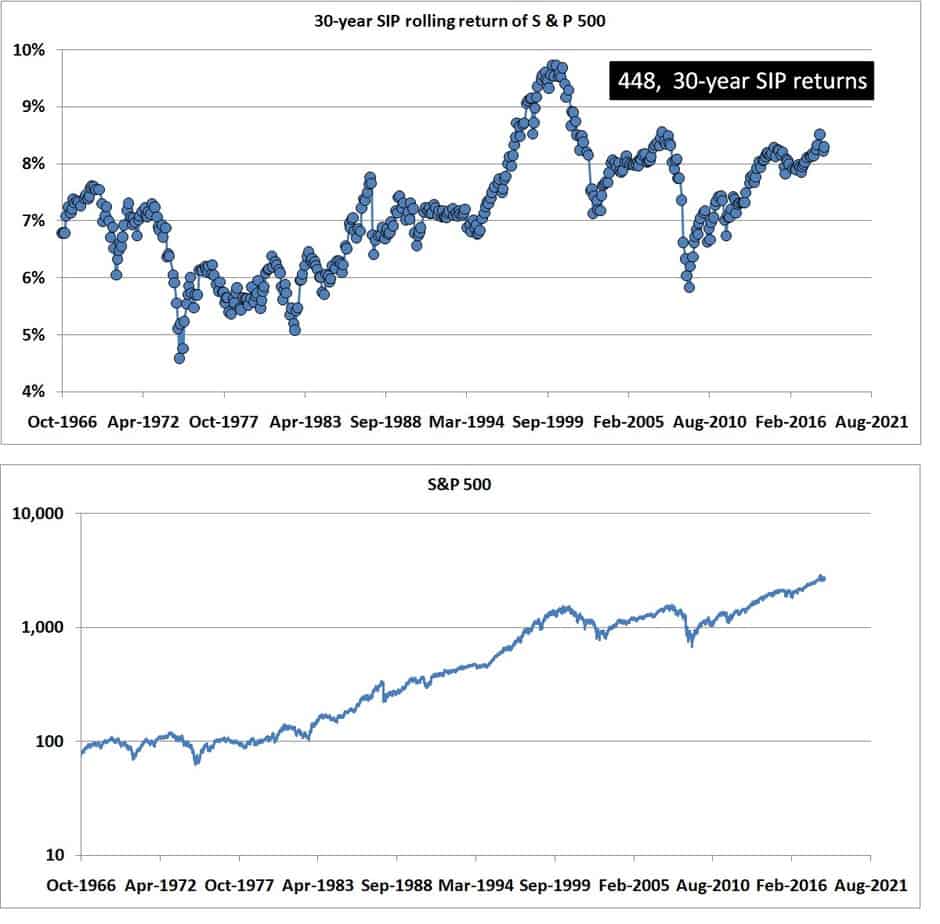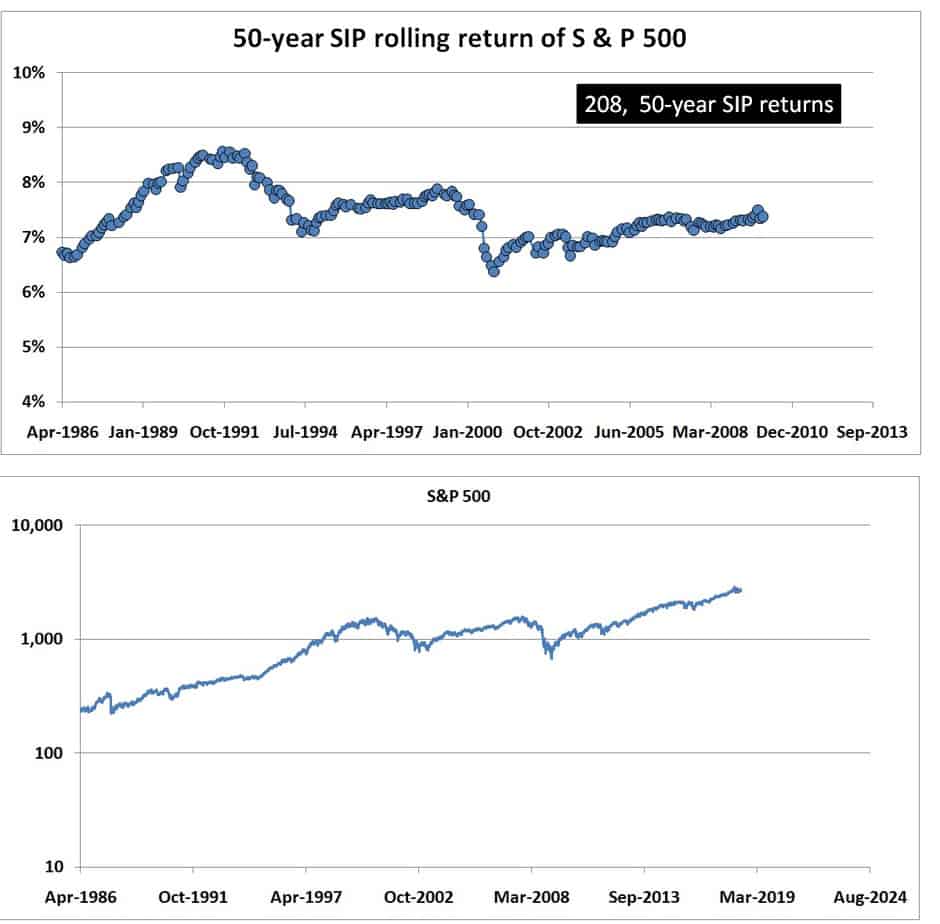Last Updated on December 28, 2021 at 6:42 pm
It is a genius plan. Simply tell the naive investor that one should not time the market and invest regularly via SIP as it will reduce risk. Convince them that automating something will make them disciplined and show them a few select data points of how rewarding this approach has been. Then the seller gets regular commissions from the investment value (not amount), the AMC gets regular AUM. Happy-happy-happy. What about the investor? Is there any proof that a SIP actually works?
Short-answer: If you look at the data without bias, the answer is NO. Unmanaged SIPs are simply subject to timing luck. Regular readers may be aware that this is a point I have mentioned time and time and time again:
A Mutual Fund SIP is Hope, Not a Strategy!
Dollar Cost Averaging aka SIP analysis of S&P 500 and BSE Sensex
Join 32,000+ readers and get free money management solutions delivered to your inbox! Subscribe to get posts via email! (Link takes you to our email sign-up form)
🔥Want to create a complete financial plan? Learn goal-based investing? Exclusive access to our DIY tools? Increase your income with your skills? Enjoy massive discounts on our robo-advisory tool & courses! 🔥
Beware of Misinformation: Mutual Fund SIPs Do Not Reduce Risk!
Don’t get too comfortable with equity: This is how a real market crash “feels” like
Don’t Be Fooled: SIP is NOT systematic investing!
Lessons from my SIP in Sundaram Select Midcap Fund
So why one more post? Three reasons: (1) introduce the idea of timing luck as it is a simple way to convey a basic market truth. (2) Present new results with an updated rolling SIP calculator and extended S&P 500 daily data (3) Crunching data in excel is my way out of depression.
What is timing luck?
It essentially means the reward or risk in your portfolio is determined by when you buy, sell, rebalance etc. In this context, it means, when you start a SIP determines your returns. When you start following a PE or 200-DMA strategy will determine your returns and so on. Active management will reduce this variation in returns but not eliminate it.
What return will you get if you did a SIP in a SENSEX Index fund?
Let us answer this question over different durations. If we are looking at a five year period, we will consider all possible 5Y periods from 1979 to 2018 and change the time of starting the SIP by one month. The date you see in the horizontal axis refers to the SIP start date.
Five year SIP
So there 408 blue dots, each of which is the return from a 5-year SIP in the Sensex. You can add returns from dividends of about 1% for <10 years, but also reduce about 0.5-1% due to expenses. Notice that return are 0% for many durations. This means that there is a loss and Excel cannot compute the return! Anyone with a conscience will admit that what return you will get is plain pot-luck. Of course, if I say the truth, I cannot sell SIPs.
Ten year SIP
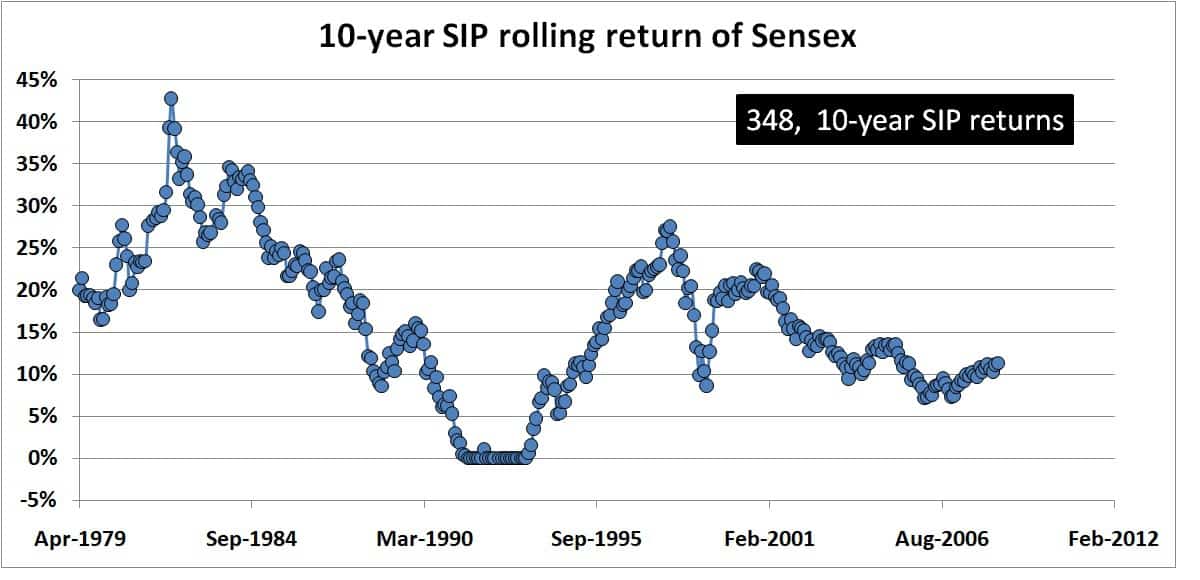 Notice that even a 10-Y sip reacts sharply to market ups and downs – more on this below. So what return will you get from an unmanaged SIP over 10Y?
Notice that even a 10-Y sip reacts sharply to market ups and downs – more on this below. So what return will you get from an unmanaged SIP over 10Y?
Fifteen year SIP
Plenty of single-digit returns after 15Y too. Remember you can add 2% for reinvested dividends to the returns but must remove about 0.5-1% for expenses and about 1% for tax. And please don’t tell me there is a one lakh tax-free LTCG limit. You want that to still apply to you after 15 years?
Also, notice that the number of blue dots decreases as the duration is increased. This means that for long durations, we simply do not know what kind of returns the Indian markets will offer. We have no history. Of course, if I wanted to sell SIPs, I will not worry about such things and talk about the India growth story. Plenty of suckers around to fall for that.
Remember “time in the market” does not mean more returns! See: How can a 400% profit result only in 8% return?! Hodling to the moon Risk!
Twenty-year SIP
Twenty five-year SIP
Thirty-year SIP
Now, don’t get carried away. SIPs themselves only came into existence in the early 2000s. The place to look at the fate of truly long-term SIPs is the S&P 500. So in what follows we look at SIP returns from 1929.
S&P 500 30-year SIP returns
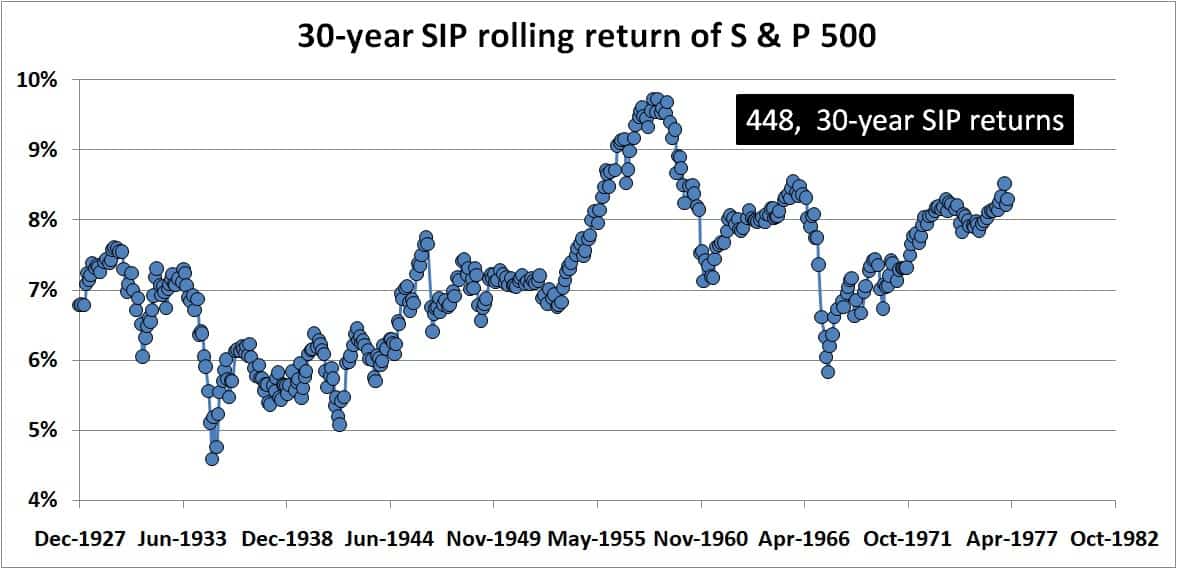 Remember that about 1-2% dividends should be added, but taxation will reduce returns to almost the same extent (depending on income levels). Also, about 0.1% or so deducted due to expenses.
Remember that about 1-2% dividends should be added, but taxation will reduce returns to almost the same extent (depending on income levels). Also, about 0.1% or so deducted due to expenses.
Any return below 6% or so would not have beat inflation after tax and there are plenty of those. Wait a minute, how practical is a 30-Y SIP in the first place!! Of course, it is not practical, but it does illustrate one important aspect of the SIP. IT DOES NOT REDUCE MARKET RISK!!
Look at the same 30-Y return graph now plotted against SIP end date and the market movement below.
Notice how even after 30 years, the final SIP return depends on the market state when you exit. This is because all SIP does is average the buying price of your investments. Over time, you would have accumulated a lump sum which is subject to the full market risk. Now let us repeat this graph over 40 and 50 years!
S&P 500 40-year SIP returns
S&P 500 50-year SIP returns
You can SIP for a lifetime and still not escape market ups and downs!! A SIP will not reduce risk, you have to do that yourself – see below. The point I am trying to make is that an unmanaged SIP is simply too risky as you relying on luck for it to work.
Timing luck is still applicable for “buying low and selling high”
Whatever market timing strategy you use, PE, PB, DMA, etc. you simply cannot escape from timing luck but can reduce it. This is evident from the previous posts:
Want to time the market with Nifty PE? Learn from Franklin Dynamic PE Fund
Nifty 200 DMA: Buying High vs Buying Low
Is PB-based investing better than PE-based investing?
Misconceptions about the Nifty PE
So what is the solution?
1: Never ever assume you can “a lot of equity exposure” because your goals are far away.
2: Never ever start a SIP without a proper asset allocation strategy. In fact, I would say invest each month on your own and do not automate it. This way, you will have full control and change investment amounts as you please.
3: Have a clear plan of how to reduce equity. I have recently shown that even when initial returns are poor, if you reduce equity as per a set plan, you have a decent chance of achieving your target. Remember we cannot spend returns, we need money. See: How to reduce risk in an investment portfolio
4: Forget about tax and market movements. Rebalance your portfolio at least once a year. See: Managing Risk Without Stopping Mutual Fund SIPs
If you just start a SIP and assume things will be alright, you are riding your luck. SIP is merely a practical way of investing because we get paid periodically. It has nothing to do with discipline or risk reduction. Don’t listen to the sales guys or the AMCs. Learn risk management on your own or consult a SEBI registered fee-only financial planner and discuss risk reduction strategies with them.
🔥Enjoy massive discounts on our courses, robo-advisory tool and exclusive investor circle! 🔥& join our community of 7000+ users!
Use our Robo-advisory Tool for a start-to-finish financial plan! ⇐ More than 2,500 investors and advisors use this!
Track your mutual funds and stock investments with this Google Sheet!
We also publish monthly equity mutual funds, debt and hybrid mutual funds, index funds and ETF screeners and momentum, low-volatility stock screeners.





- Do you have a comment about the above article? Reach out to us on Twitter: @freefincal or @pattufreefincal
- Have a question? Subscribe to our newsletter using the form below.
- Hit 'reply' to any email from us! We do not offer personalized investment advice. We can write a detailed article without mentioning your name if you have a generic question.
Join 32,000+ readers and get free money management solutions delivered to your inbox! Subscribe to get posts via email! (Link takes you to our email sign-up form)
About The Author
 Dr M. Pattabiraman(PhD) is the founder, managing editor and primary author of freefincal. He is an associate professor at the Indian Institute of Technology, Madras. He has over ten years of experience publishing news analysis, research and financial product development. Connect with him via Twitter(X), Linkedin, or YouTube. Pattabiraman has co-authored three print books: (1) You can be rich too with goal-based investing (CNBC TV18) for DIY investors. (2) Gamechanger for young earners. (3) Chinchu Gets a Superpower! for kids. He has also written seven other free e-books on various money management topics. He is a patron and co-founder of “Fee-only India,” an organisation promoting unbiased, commission-free investment advice.
Dr M. Pattabiraman(PhD) is the founder, managing editor and primary author of freefincal. He is an associate professor at the Indian Institute of Technology, Madras. He has over ten years of experience publishing news analysis, research and financial product development. Connect with him via Twitter(X), Linkedin, or YouTube. Pattabiraman has co-authored three print books: (1) You can be rich too with goal-based investing (CNBC TV18) for DIY investors. (2) Gamechanger for young earners. (3) Chinchu Gets a Superpower! for kids. He has also written seven other free e-books on various money management topics. He is a patron and co-founder of “Fee-only India,” an organisation promoting unbiased, commission-free investment advice.Our flagship course! Learn to manage your portfolio like a pro to achieve your goals regardless of market conditions! ⇐ More than 3,000 investors and advisors are part of our exclusive community! Get clarity on how to plan for your goals and achieve the necessary corpus no matter the market condition is!! Watch the first lecture for free! One-time payment! No recurring fees! Life-long access to videos! Reduce fear, uncertainty and doubt while investing! Learn how to plan for your goals before and after retirement with confidence.
Our new course! Increase your income by getting people to pay for your skills! ⇐ More than 700 salaried employees, entrepreneurs and financial advisors are part of our exclusive community! Learn how to get people to pay for your skills! Whether you are a professional or small business owner who wants more clients via online visibility or a salaried person wanting a side income or passive income, we will show you how to achieve this by showcasing your skills and building a community that trusts and pays you! (watch 1st lecture for free). One-time payment! No recurring fees! Life-long access to videos!
Our new book for kids: “Chinchu Gets a Superpower!” is now available!


Must-read book even for adults! This is something that every parent should teach their kids right from their young age. The importance of money management and decision making based on their wants and needs. Very nicely written in simple terms. - Arun.Buy the book: Chinchu gets a superpower for your child!
How to profit from content writing: Our new ebook is for those interested in getting side income via content writing. It is available at a 50% discount for Rs. 500 only!
Do you want to check if the market is overvalued or undervalued? Use our market valuation tool (it will work with any index!), or get the Tactical Buy/Sell timing tool!
We publish monthly mutual fund screeners and momentum, low-volatility stock screeners.
About freefincal & its content policy. Freefincal is a News Media Organization dedicated to providing original analysis, reports, reviews and insights on mutual funds, stocks, investing, retirement and personal finance developments. We do so without conflict of interest and bias. Follow us on Google News. Freefincal serves more than three million readers a year (5 million page views) with articles based only on factual information and detailed analysis by its authors. All statements made will be verified with credible and knowledgeable sources before publication. Freefincal does not publish paid articles, promotions, PR, satire or opinions without data. All opinions will be inferences backed by verifiable, reproducible evidence/data. Contact information: To get in touch, use this contact form. (Sponsored posts or paid collaborations will not be entertained.)
Connect with us on social media
- Twitter @freefincal
- Subscribe to our YouTube Videos
- Posts feed via Feedburner.
Our publications
You Can Be Rich Too with Goal-Based Investing
 Published by CNBC TV18, this book is meant to help you ask the right questions and seek the correct answers, and since it comes with nine online calculators, you can also create custom solutions for your lifestyle! Get it now.
Published by CNBC TV18, this book is meant to help you ask the right questions and seek the correct answers, and since it comes with nine online calculators, you can also create custom solutions for your lifestyle! Get it now.Gamechanger: Forget Startups, Join Corporate & Still Live the Rich Life You Want
 This book is meant for young earners to get their basics right from day one! It will also help you travel to exotic places at a low cost! Get it or gift it to a young earner.
This book is meant for young earners to get their basics right from day one! It will also help you travel to exotic places at a low cost! Get it or gift it to a young earner.Your Ultimate Guide to Travel
 This is an in-depth dive into vacation planning, finding cheap flights, budget accommodation, what to do when travelling, and how travelling slowly is better financially and psychologically, with links to the web pages and hand-holding at every step. Get the pdf for Rs 300 (instant download)
This is an in-depth dive into vacation planning, finding cheap flights, budget accommodation, what to do when travelling, and how travelling slowly is better financially and psychologically, with links to the web pages and hand-holding at every step. Get the pdf for Rs 300 (instant download)